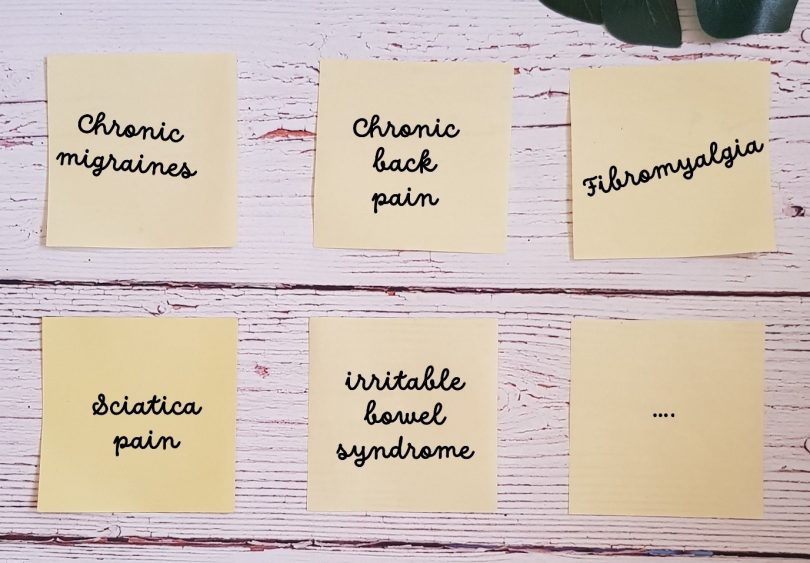Why disentanglement, and changing our language around pain, are crucial to healing.
When you finally receive a diagnosis for your condition it can almost feel like a relief. After months, or years, of pain, of doctors not knowing what is “wrong with you”, because “you don’t look sick”, not in person, nor according to their scans. So, when you can finally give it a name, it confirms the feeling that you had all along, a knowing deep down that you’re NOT crazy, and there is finally someone that’s listening that can confirm it. If you have been dealing with chronic symptoms this might sound all too familiar.
Obviously, receiving a chronic diagnosis is not a celebratory moment, it is a life sentence, especially the way it is being dealt with in our current medical system. Yet, without labels, there is no treatment plan or solution offered, so receiving a diagnosis, in that sense, feels like a step in the right direction. When it comes to acute pain and injury, it is a very effective system. In the case of chronic condition, however, it has proven to be less helpful.
John Bedson, MD, wrote in an article in the British Journal of General Practice “that attaching a diagnostic label, such as fibromyalgia, may actually be harmful to the patient because it creates the illusion that there is a definitive disease and pathology underlying the symptoms, and this itself may contribute to persisting pain and disability.”¹
The majority of chronic pain conditions are primarily brain induced, as discussed in earlier articles, so therefore looking for a physical diagnosis and treating it as such, is unsurprisingly ineffective. But that’s not the main point I want to address today. Today, I want to highlight the impact of labelling, the language we use around pain, and how this might be doing more harm than good for chronic pain patients.
The Nocebo Effect
To begin with, there is the impact of the nocebo effect. Whereas the placebo effect is known to have a positive impact on an individual’s healing journey, because they believe that they are healing even if in reality they are only taking a dummy medication, the nocebo effect has the reverse effect. When a person in pain is told that their condition is chronic, and they believe there is NO possibility of healing, the mind absorbs this in the same way as it does with a placebo treatment. The fact that this message is delivered by a doctor, adds credibility, and only increases the belief.
“When the doctor erroneously tells the patient he has a bad back, or shoulder, or knee, suffering naturally increases due to the nocebo effect. The doctor has now delayed her healing indefinitely with faulty medical advice—and harmed her.” Steve Ozanich²
Labels Leading to Identification
Leaving the doctor’s office with a label, often accompanied by the term, chronic illness, can lead to identification with the condition, where you fully embrace it as part of yourself. Especially if you have been living with chronic pain for a long time. It can be difficult to imagine a life without it, let alone a SELF that is pain-free. It’s just part of who you are now and your day-to-day reality. Fully embracing it, and accepting the pain as a part of you, carries with it a sense of empowerment, and self-acceptance.
Language
Our language around the condition might start to change as well. The language we start using can sound like: “my back pain…, my fibro…, my bad knee…” when talking about it. This happens naturally almost unconsciously. The repetition of this makes the condition and the pain so ingrained in our psyche reconfirming every day that this pain IS me.

The term warrior is something I come across often when browsing social media and reading stories of people that are living with chronic pain conditions. Using terms like fighter or warrior can make us feel strong and more capable to deal with it. And it makes total sense, because it takes an enormous amount of strength to deal with the pain day in and day out, so I get it, I really do.
Yet, I also want to shed light on another side of this identification, because this is a perspective that I think is valuable and isn’t discussed often. The warrior and fighter identity are a very masculine approach to dealing with pain, one that embodies resistance, telling the pain that it will not bring us down, we will survive despite it. As much as it may feel empowering, or accepting, or even as a form of self-love, this kind of identification makes it impossible to separate oneself from the conditions. It also creates a strong sense of resistance. In the famous words of the psychologist Carl Jung: “What we resist, not only persists, but grows in size.”³ This fighting mentality and resistance to the pain, is exactly what feeds the pain.
Stop Fighting
Some of you might want to yell at me at this point: “But Rebecca, what am I meant to do then?!?!” Because what else are you meant to do with debilitating pain? Ironically, the only effective method is to stop fighting, and start surrendering into it, so you can let your brain know that you are no longer in danger. The moment we stop fighting and allow it to be, breathe through it and embrace it, is when you allow healing to take place. Easier said than done because it freaking hurts, right? I hear you! But if you knew that after a while this will help you turn down the pain volume, isn’t it worth a shot?
To some the answer might still be NO, thanks! and I respect that. Yet, I hope that a few of you out there are brave (or call it crazy) enough to give it a try. To connect with that pain and just allow it, surrendering into it and take a more nurturing role rather than the pain slaying warrior.
Because sitting with your pain, listening to your body, and sending your brain messages of safety is what eventually calms down the sympathetic nervous system. When the brain knows that you are safe it can start learning to stop firing the pain signals, turning down the pain dial in the process (read more about this here)

Disentanglement
Another thing to focus on is the language you use in relation to “your pain“. Instead of referring to it as “my back pain…, my fibro…, my bad knee…” try to think of ways to distance yourself from it, so you start seeing it as something separate from you, and as something temporary rather than fixed. For example, you could say “I am experiencing a pain flare up in my back” (the back is still Yours, no discussion there). The second step is taking it a step further, by removing the word pain all together, and refer to what you are feeling as sensations, which is a more neutral term and helps to make the experience feel less charged. This might feel very unnatural in the beginning, even ridiculous, yet these type of reframes have proven to be very effective and are used in various forms of therapy.⁴
Conclusion
My aim with this article is not to point at faults in behaviour, it is merely to shed some light on the psychological mechanisms that work in the background, without our awareness, that may not be helpful even if the original thought behind it feels loving and empowering. The warrior mindset and embracing a condition as part of us feels like the right thing to do, especially when we believe this condition is for life. Yet, for the majority of chronic pain conditions this is not the case, and healing can actually happen. For this, we need to switch our focus from our body to our brain, and from fighting to nurturing.
If you are still in doubt about the mind-based approach, check out the recent discoveries like the Boulder Back Pain Study ⁵, which has shown that a psychological approach to chronic pain is more effective than the traditional methods. I won’t go into details here, but if you need proof before you can start shifting your focus, I encourage you to check out their results.
References:
- https://www.ncbi.nlm.nih.gov/pmc/articles/PMC1326113/
- Steve Ozanich, The Great Pain Deception: Faulty Medical Advice is Making US Worse, 2018 p. 136
- https://www.psychologytoday.com/us/blog/evolution-the-self/201606/you-only-get-more-what-you-resist-why
- https://www.verywellmind.com/reframing-defined-2610419
- https://www.colorado.edu/today/2021/09/29/how-therapy-not-pills-can-nix-chronic-pain-and-change-brain




Leave a Comment